Mail Merge in Microsoft 2016
Mail merge using an Excel spreadsheet
Mail merge is used to create multiple documents at once. These documents have identical layout, formatting, text, and graphics. Only specific sections of each document varies and is personalized. The documents Word can create with mail merge include bulk labels, letters, envelopes, and emails. There are three documents involved in the mail merge process:
Your main document
Your data source
Your merged document
Step 1: Prepare data in
Excel for mail merge
The most important step in the mail merge process is to set up and
prepare your data. You'll use your Excel spreadsheet as the data source for the
recipient list.
Here are some tips to prepare your data for a mail merge. Make sure:
1. Column names in your spreadsheet match the field names you want to
insert in your mail merge. For example, to address readers by their first name
in your document, you'll need separate columns for first and last names.
2. All data to be merged is present in the first sheet of your spreadsheet.
3. Data entries with percentages, currencies, and postal codes are
correctly formatted in the spreadsheet so that Word can properly read their
values.
4. The Excel spreadsheet to be used in the mail merge is stored on your
local machine.
5. Changes or additions to your spreadsheet are completed before it's
connected to your mail merge document in Word.
Step 2: Start the mail
merge
1. In Word,
choose File > New > Blank
document
2. On
the Mailings tab, in the Start Mail merge group,
choose Start Mail Merge, and then choose the kind of merge you want
to run.
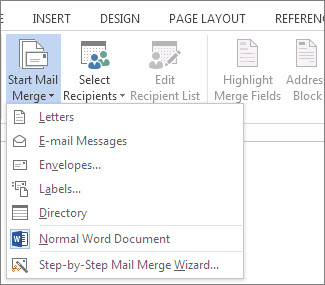
3. Choose Select
Recipients > Use an Existing List.

4. Browse to
your Excel spreadsheet, and then choose Open.
5. If Word
prompts you, choose Sheet1$ > OK.
Edit your mailing list
You can limit who receives your mail.
1. Choose Edit
Recipient List.
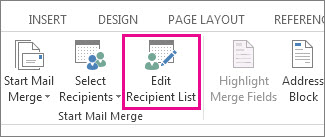
2. In
the Mail Merge Recipients dialog box, clear the check box next
to the name of any person who you don't want to receive your mailing.
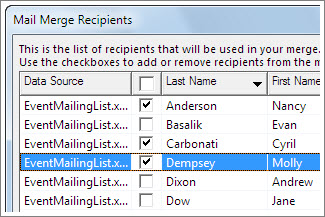
Step 3: Insert a merge
field
You can insert one or more mail merge fields that pull the information
from your spreadsheet into your document.
To insert an address block for an envelope, a label, an email message,
or a letter
1. On
the Mailings tab, in the Write & Insert Fields group,
choose Address Block.
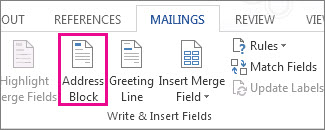
2. In
the Insert Address Block dialog box, choose a format for the
recipient's name as it will appear on the envelope.
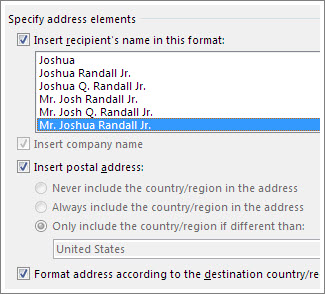
3. Choose OK.
4. Choose File > Save.
To insert a greeting line in an email message or a letter
1. On
the Mailings tab, in the Write & Insert Fields group,
choose Greeting Line.
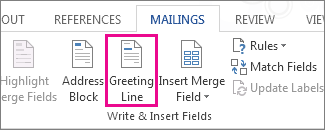
2. In
the Insert Greeting Line dialog box, do the following:
o Under Greeting line format, change the salutation if
necessary by choosing the greeting (Dear is the default), the
format for the recipient name, and the ending punctuation (a comma is the
default).
and
o
Under Greeting line for invalid recipient names, choose an
option in the salutation list.
3. Choose OK.
4. Choose File > Save.
To insert data from your spreadsheet in an email message or a letter
1. On
the Mailings tab, in the Write & Insert Fields group,
choose Insert Merge Field.
2. In
the Insert Merge Field dialog box, under Fields,
choose a field name (column name in your spreadsheet), and then choose Insert.
3. Repeat
step 2 as needed, and choose Close when done.
4. Choose File > Save.
Step 4: Preview and finish
the mail merge
After you insert the merge fields you want, preview the results to
confirm that the content is okay. and then you're ready to complete the merge
process.
1. On
the Mailings tab, choose Preview Results.
1. Choose
the Next or Previous record
button to move through records in your data source and view how the records
will appear in the document.
In
the Finish group, choose Finish & Merge, and
choose Print Documents or Send E-mail Messages.
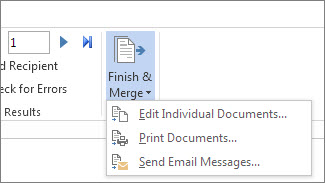
Step 5: Save your mail
merge
When you save the mail merge document, it stays connected to your data
source. You can reuse the mail merge document for your next bulk mailing.
·
Open the mail merge document and choose Yes when Word
prompts you to keep the connection.
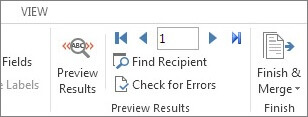
Comments
Post a Comment